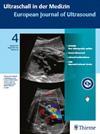Ultrasound Imaging of the Sciatic Nerve.
IF 3.1
3区 医学
Q1 ACOUSTICS
引用次数: 0
Abstract
Abstract The sciatic nerve (SN) is the biggest nerve in the human body and innervates a large skin surface of the lower limb and several muscles of the thigh, leg, and foot. It originates from the ventral rami of spinal nerves L4 through S3 and contains fibers from both the posterior and anterior divisions of the lumbosacral plexus. After leaving the neural foramina, the nerve roots merge with each other forming a single peripheral nerve that travels within the pelvis and thigh. Non-discogenic pathologies of the SN are largely underdiagnosed entities due to nonspecific clinical tests and poorly described imaging findings. Likewise, to the best of our knowledge, a step-by-step ultrasound protocol to assess the SN is lacking in the pertinent literature. In this sense, the aim of the present manuscript is to describe the normal sono-anatomy of the SN from the greater sciatic foramen to the proximal thigh proposing a standardized and simple sonographic protocol. Then, based on the clinical experience of the authors, a few tips and tricks have been reported to avoid misinterpretation of confounding sonographic findings. Last but not least, we report some common pathological conditions encountered in daily practice with the main purpose of making physicians more confident regarding the sonographic “navigation” of a complex anatomical site and optimizing the diagnosis and management of non-discogenic neuropathies of the SN.坐骨神经的超声成像。
坐骨神经(SN)是人体最大的神经,支配下肢的大皮肤表面以及大腿、腿和脚的几块肌肉。它起源于L4至S3脊神经的腹侧分支,并包含来自腰骶丛后部和前部的纤维。离开神经孔后,神经根相互融合,形成一条在骨盆和大腿内行进的外周神经。SN的非椎间盘源性病理在很大程度上是诊断不足的实体,这是由于非特异性的临床测试和缺乏描述的成像结果。同样,据我们所知,相关文献中缺乏评估SN的分步超声方案。从这个意义上说,本手稿的目的是描述从坐骨大孔到大腿近端的SN的正常超声解剖结构,提出一个标准化和简单的超声方案。然后,根据作者的临床经验,报道了一些技巧和窍门,以避免混淆超声检查结果的误解。最后但并非最不重要的是,我们报告了日常实践中遇到的一些常见病理状况,主要目的是让医生对复杂解剖部位的超声“导航”更有信心,并优化SN非椎间盘源性神经病的诊断和管理。
本文章由计算机程序翻译,如有差异,请以英文原文为准。
求助全文
约1分钟内获得全文
求助全文
来源期刊

Ultraschall in Der Medizin
医学-核医学
CiteScore
5.30
自引率
8.80%
发文量
228
审稿时长
6-12 weeks
期刊介绍:
Ultraschall in der Medizin / European Journal of Ultrasound publishes scientific papers and contributions from a variety of disciplines on the diagnostic and therapeutic applications of ultrasound with an emphasis on clinical application. Technical papers with a physiological theme as well as the interaction between ultrasound and biological systems might also occasionally be considered for peer review and publication, provided that the translational relevance is high and the link with clinical applications is tight. The editors and the publishers reserve the right to publish selected articles online only. Authors are welcome to submit supplementary video material. Letters and comments are also accepted, promoting a vivid exchange of opinions and scientific discussions.
 求助内容:
求助内容: 应助结果提醒方式:
应助结果提醒方式:


